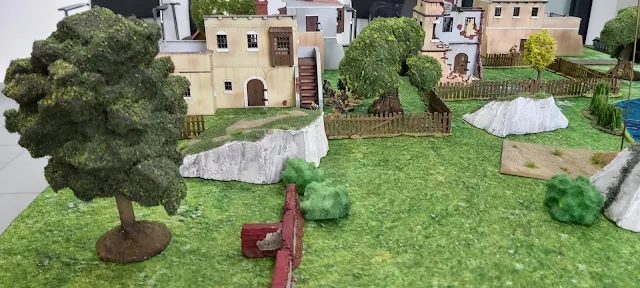This scenario is inspired by events that took place 7th of May 1942 near Misima Island. Japaneese main assault Force heading Port Moresby was noticed by the US reconnaissance units. The fleet consist of one light carrier Shoho, four heavy cruisers and some minor ships was attacked by the bombers USN TF17.
The Americans managed to make attack by surprise. Limited CAP tried to engage US bombers, when the other Zero and Claude fighters tried to take off under enemy fire. Japaneese fleet lined up in tied, diamond like formation with a cruisers settting up heavy flak barrage.
Opposing forces:
US NAVY airforce consist of three squadrons: 6 Dauntless dive bombers (regular), 6 Devastators torpedo bombers (regular), 3 Wildcat fighters (regular) is an attacking force. Primary target for the attacker is to sink enemy carrier. Secondary target is to make as much damage on other Japaneese ships as possible.
Japaneese fleet and Navy airforce consist of 1 carrier, two cruiser ships, up to six A6M2 Zero fighters (regular) and - optional - six D3A Val as a substitute fighters (rookie) ist considered to be defender.
Deployment sequence
At the begining, defender player places carrier marker (it could be 10" long marker or a model - I'm using 1/700 ones) in the center of the 4'x4' table. 12" from each side of the carrier place cruisers markers. Then attacker places his squadrons in minimum 2 aircraft elements 1" from the any table edge (the player may choose initial advantage level). When the attacking force is deployed defender may set up his flak barrage: 4 per each ship. The player can use it against high operating targets (flak barrage) or huging the waves (splash barrage). At the end defender places element consist of 2 Zeros in High cover on any table edge. The rest of Japaneese fighters are "on deck" and may take off after actication of all aircrafts on table.
Special rules
Instant take off: When the all other planes on table are finished, the defender player may try to take off with up to two fighters (within a limit). To do so he need to make a maneouvre test for each plane. If succesfull place the model 1" from the carrier prow in disadvantage state.
Staffing deck: the attacker may choose to make a straffing attack against carrier deck. For each success remove one Japaneese fighter being there.
Evasive actions: at the begining of any turn defender plyer may decide evasive actions for his carrier. For each succesfull attack this turn you need to roll D6. On 4+ the hit is scored as normal, otherwise is dodged by the carrier. Aircrafts cannot take off from the carrier making evasive action the same turn.
No hope for retreat: Enemy attacking home deck. Japaneese fighter squadron in this scenario is unbreakable.
Victory:
Sinking of Shoho means automatic attacker victory, breaking all bomber squadrons (without sinking Shoho) means defender victory. In any other case sum up Victory points: 1VP for each inflicted Boom chit, 1VP for each inflicted hull hit.
Optional rules
Battle plan: Before deployment attacker dividing his force into battlegroups and secretly writing down targets for each of them. To determine the victor in this option the players need to sum up the victory points (defenders as above), attacker double his VP for each objective completed and deduct the value of VP for not completed objecitves. Battlegroups cannot attack other target than appointed at the begining of battle.





















































